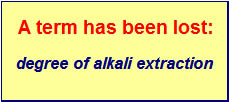
 |
| Relationship between beet analyses and technological value of sugar beet. | |
| L. Wieninger and N. Kubadinow, CITS report (1971), pp. 523-537 (German). |

|
Studying the paper, one will find values of 84.6 % for potassium extraction and 84.4 % for sodium extraction. On page 531 the molasses sugar is calculated from alkalies in beet and alternatively from αN in beet, but no use was made from these degrees of extraction. |
|
In the following corrected calculation the two degrees of extraction are averaged out simply as 84.5 %, in spite of very different concentrations of K and Na. Beet analyses: | |
|
17.56 % sugar in beet 24.37 mmol K / 100 g sugar in beet 5.87 mmol Na / 100 g sugar in beet 17.77 mmol αN / 100 g sugar in beet | |
| Calculation on page 531: | |
|
(24.37 + 5.87) * 1.02 * 0.3423 = 10.56 % molasses sugar on sugar in beet (24.37 + 5.87) * 1.02 * 0.3423 * 0.1756 = 1.854 % molasses sugar on beet | instead of including the degree of extraction: |
|
(24.37 + 5.87) * 0.845 * 1.02 * 0.3423 = 8.92 % molasses sugar on sugar in beet (24.37 + 5.87) * 0.845 * 1.02 * 0.3423 * 0.1756 = 1.567 % molasses sugar on beet | |
|
According to the authors, an alkalinity coefficient A.K. is calculated from values based on beet: A.K. = alkalies/αN. With values of A.K. lower than 1.8, a modified calculation of molasses sugar has to be used, with calculation of alkalies on beet from 1.8 * αN on beet: | |
|
17.77 * 1.8 * 1.02 * 0.3423 = 11.168 % molasses sugar on sugar in beet 17.77 * 1.8 * 1.02 * 0.3423 * 0.1756 = 1.961 % molasses sugar on beet | |
|
With the modified calculated value of alkalies on beet, the degree of extraction for alkalies is again necessary in the formulas: | |
|
17.77 * 1.8 * 0.845 * 1.02 * 0.3423 = 9.437 % molasses sugar on sugar in beet 17.77 * 1.8 * 0.845 * 1.02 * 0.3423 * 0.1756 = 1.657 % molasses sugar on beet | |
| In the summary of the article formulas for M.K., R.K. and A.K. are given. The authors can therefore be considered "alkali factor scientists", because with the M.K. they state: no alkalies = no molasses sugar. This is clearly a wrong theoretical background and they assume a relationship, passing the point of origin. | |
| 2004-08-08 G. Pollach |
 |
 |